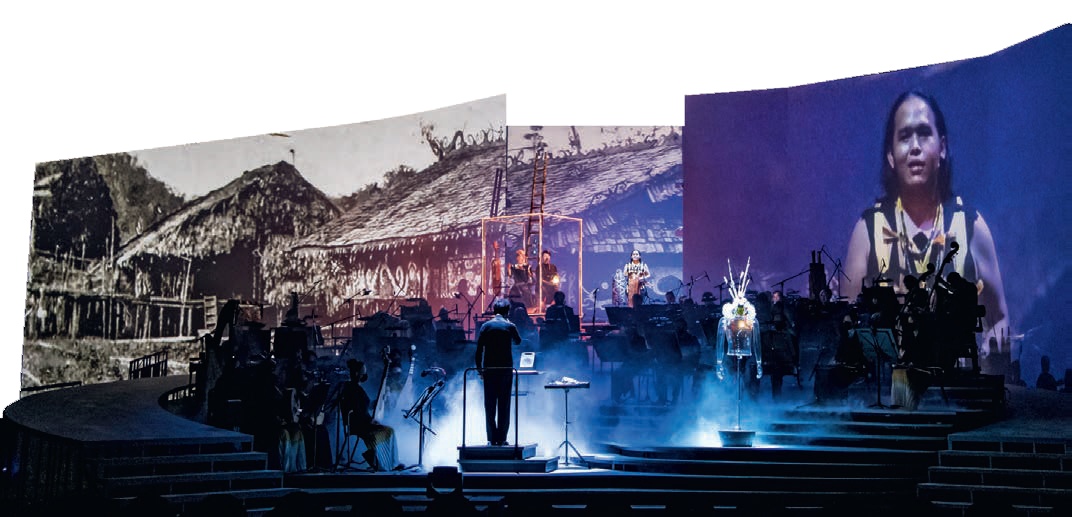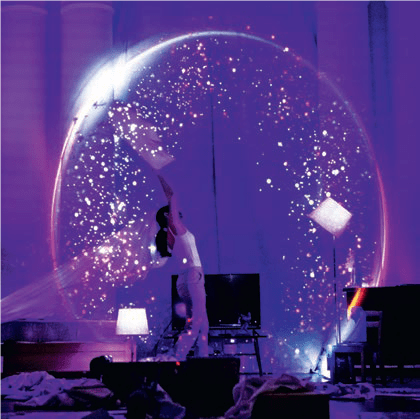Stories > Taking Centre Stage
Taking Centre Stage
Natalie Hennedige, director of the Singapore International Festival of the Arts, shares how global collaboration underscores the event’s programming.
BY ALYWIN CHEW

nternational arts festivals are more than just about showcasing virtuosity across the spectrum of art disciplines. At the heart of all these events lies the salient element of cultural exchange, which could bridge differences and foster greater understanding between peoples.
That is according to Natalie Hennedige, founder and artistic director of contemporary performance company Cake, who will helm the Singapore International Festival of the Arts (SIFA) from 2022 to 2024.
SIFA, which is in its 45th year, was launched in 1977 as the Singapore Arts Festival to celebrate local arts that highlighted the island nation’s cultural diversity. The month-long annual event has since grown to include international artistes in the disciplines of theatre arts, dance, music and visual arts.
For the newly appointed festival director, it was Mepaan – the opening act of SIFA 2022 featuring the Singapore Chinese Orchestra and the Sarawak based community arts management company Tuyang Initiative - that opened her eyes to the cross-cultural character of the event.
This is because while most of us typically identify singing and dancing on stage as artistic performance, such acts are as natural as breathing and communing to the Kenyah and Kayan natives of Sarawak. “The cultural practitioners we work with do not consider what they do on stage to be performance. They are being present, as themselves,” Hennnedige explains.

Singapore theatre company Teater Ekamatra celebrates the region’s cultural vibrancy through its remake of Shakespeare's classic A Midsummer Night’s Dream, inspired by the splendour of Bangsawan – a form of Malay opera – and Nusantara, the Indonesian archipelago.
This realisation compelled her to change the approach she would typically take with actors or dancers – and would ultimately shape how Mepaan was designed. “The question at hand was not about how they should perform; it was how I could shape the conditions so they could be themselves and channel that essence,” she says.
“Art allows you to take in another’s perspective, stepping outside your own shoes and learning something about another’s experience.”
Natalie Hennedige, festival director, Singapore International Festival of the Arts
DEEP DISCOVERIES
To create such an environment, Hennedige first held online meetings during which Tuyang Initiative shared stories that would help her better understand their culture.
In one such session, performer Adrian Jo Milang spoke about how he would spend his youth learning the traditional art forms of Parap, impromptu poetic songs and Takna, which are epics about Kayan heroes, from his grandmother.
Then there was the 70-year-old sape master, Mathew Ngau Jau, who by responding to the music and improvising accordingly would play the string instrument a little differently in each performance.
“With this information in mind, we asked Harry Frederick, an indigenous filmmaker based in Sarawak, to make a short film about Adrian and his grandmother that we would play at a specific point during the performance,” shares Hennedige.
The live act also took pains to emphasise Jau’s sape carving skills via a luminescent box-frame symbolising his hut, in which he would carve a sape during the performance. A camera, which captured the details of his hands with the carving tools, was projected on large screens as part of the show.
“Listening to these stories – even if it was done online – gave rise to some powerful discoveries that when woven into the work, added layers that gave the performance nuance and depth,” says Hennedige.

Meepan, which means always in the native language of the Kayan tribe of Borneo, is a collaboration between Singapore Chinese Orchestra and Sarawak-based Tuyang Initiative. Seen on the screen is Tuyang Initiative performer Adrian Jo Milang.
EXPLORING NEW WAYS TO WORK
The festival director also points out that collaboration between artistes is pivotal as it allows for the exchange of ideas and perspectives, which ultimately helps them to grow and create more nuanced work.
It is a sentiment that Juvita Tatan Wan, producer and co-founder of Tuyang Initiative, shares. “We got to spend time with the festival team and orchestra, observing their work culture, how everyone operates, their level of professionalism and mastery of their instruments – that was a real honour for me as a producer,” she says. “Some of the traditional Chinese instruments can even mimic the sounds of the birds found in our rainforest. I must say that left all of us in awe.”
With Mepaan being performed at an unconventional venue – the decommissioned Pasir Panjang Power Station – putting together the act also required extensive coordination with different parties.
“Like the different elements within the rainforest ecosystem, artistes and cultures rely upon one another to thrive.”
Adrian Jo Milang, performer, Tuyang Initiative
“We wanted the audience to experience the orchestra in a completely different light, away from the concert hall,” she explains. “But there were several things to consider, which mainly had to do with whether we could make the acoustics work.” This resulted in the orchestra having to do a trial run at the performance venue months before the festival.
“Being patient and having focused conversations with people possessing varied specialisations – from the sound engineer to the maestro and the set designer – are vital to creating a festival of this scale,” she says.

Singaporean playwright Eleanor Wong and Filipino filmmaker John Torres teamed up to produce a multi-disciplinary work – REMOTES X QUANTUM – reimagining life in Singapore and the Philippines.
BLENDING ARTFORMS
From 2022 to 2024, SIFA will feature the same overarching title The Anatomy of Performance, which festival organiser Arts House Limited says will focus on “artistic fluidity, multidisciplinary collaboration and internationality within festival commissions and presentations in both the physical and online space”.
One such effort that left a deep impression on Hennidige was REMOTES X QUANTUM, a multimedia piece between Singapore playwright Eleanor Wong and Filipino filmmaker John Torres.
“This was a beautiful blending of film, poetry, theatre and sound that portrayed the contrasting realities between two countries in a manner that was captivating and surreal,” Hennedige enthuses. “It is wonderful the way international collaborations surface the nuances of different cultures and ways of being. In REMOTES X QUANTUM, you especially gained a sense of John’s Philippines, an impression of his homeland glimpsed through his film lens and vivid imagination.”
Another festival commission was project SALOME, which was inspired by the character Salome from Oscar Wilde’s renowned play of the same name. For this work, Singapore director Ong Keng Sen created the film with the help of Berlin-based performance artist Michael(a) Daoud before applying the completed film creation on a live stage in Singapore.
TECHNOLOGY BECOMES AN ENABLER
In response to the Covid-19 pandemic, Hennedige points out that the meaningful use of technology was an important consideration. As such, she introduced Life Profusion – the festival’s virtual platform – to showcase artistes who create works specifically for the virtual medium. “It is important for SIFA’s virtual platform to be a space where artistes are creating specifically for a virtual stage and applying digital language in artistically dynamic ways,” she says.
Among these was The Paiseh Piece, an audiovisual poem that is meant to be experienced via Instagram. The title of the work by Singaporean artist Phua Juan Yong refers colloquially to the last morsel of food during a shared meal, which remains uneaten for a long time ostensibly because diners are too paiseh (or “embarrassed” in the Hokkien dialect) to devour it.
Technology was also explored in SIFA’s live performances such as through a concert presentation by the American composer, musician and sound artist Holly Herndon.
A PhD graduate from Stanford University’s Center for Computer Research in Music and Acoustics, Herndon’s auditory creations are shaped primarily by coding software and artificial intelligence instead of musical instruments.
Come 2023, the festival’s next subtitle, Some People, will explore another aspect of the overarching theme The Anatomy of Performance. Coincidentally, the subtitle also reflects the ethos of exchange that underpins the festival. “Some People considers the spectrum of the human experience. After all, we live in the same world but experience it in different ways,” says Hennedige. “Art allows you to take in another’s perspective, stepping outside your own shoes and learning something about another’s experience.”
Transcultural and transdisciplinary performances, she notes, would again be at the heart of the festival’s programming.
“SIFA is not a platform for one perspective. It is not a platform for one point of view. It is a platform for multiple vital perspectives and conversations to ensue,” Hennedige concludes.
Or as Milang of Tuyang Initiative puts it: “Like the different elements within the rainforest ecosystem, artistes and cultures rely upon one another to thrive.”
